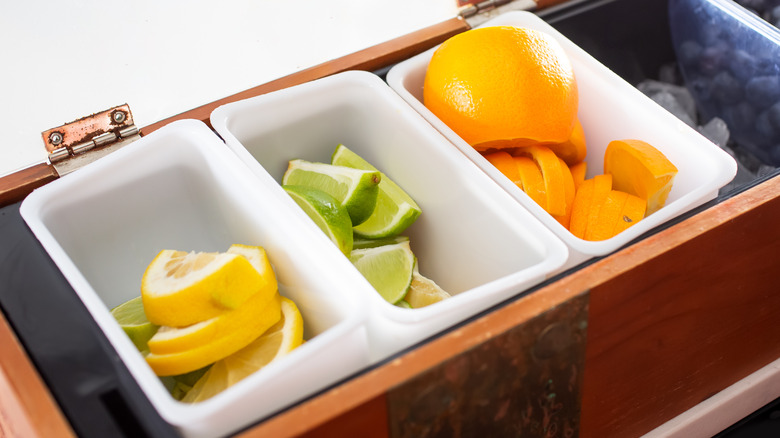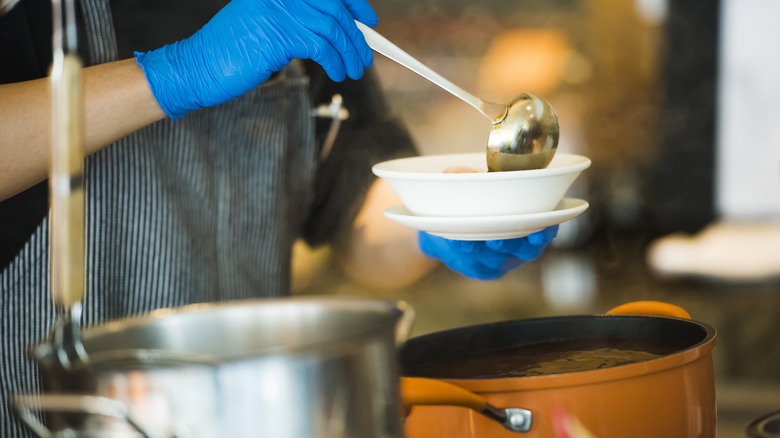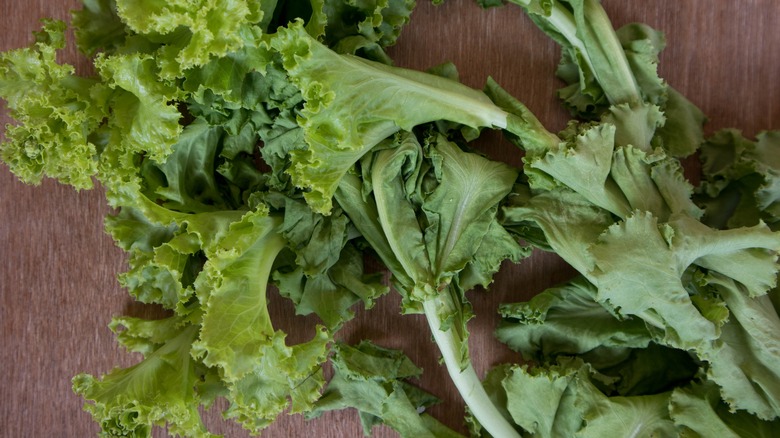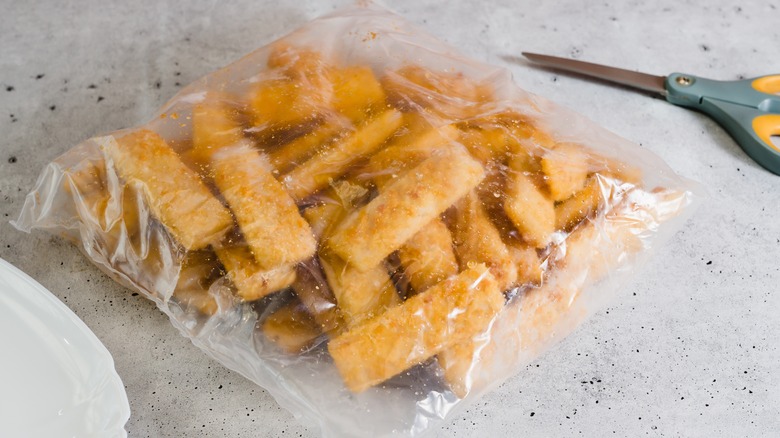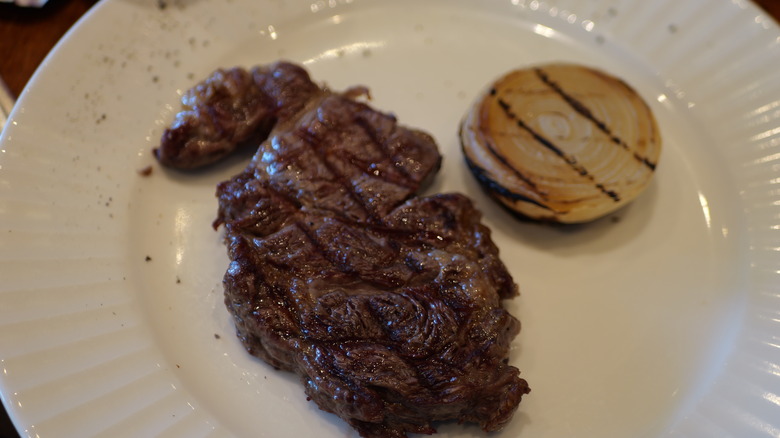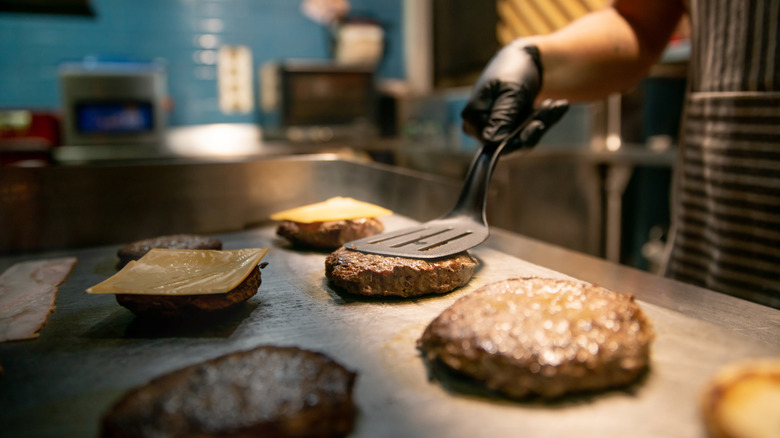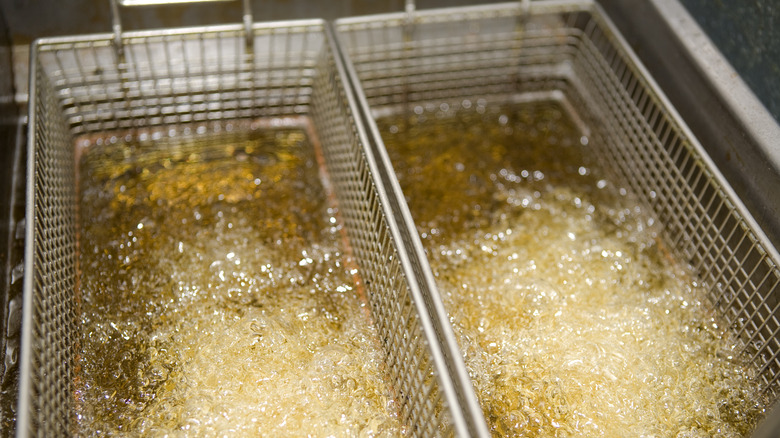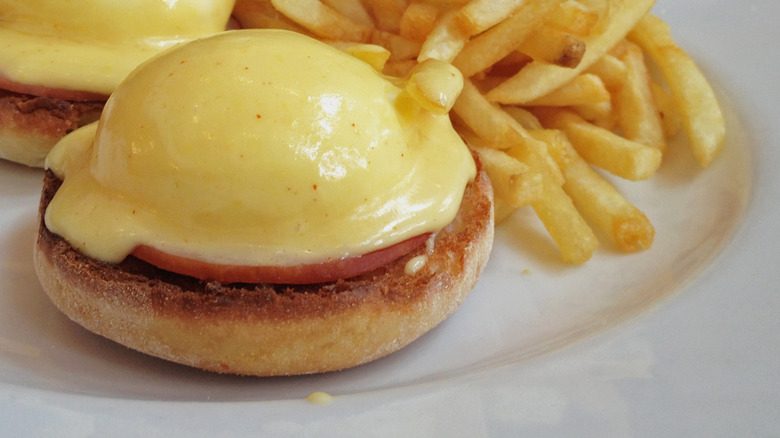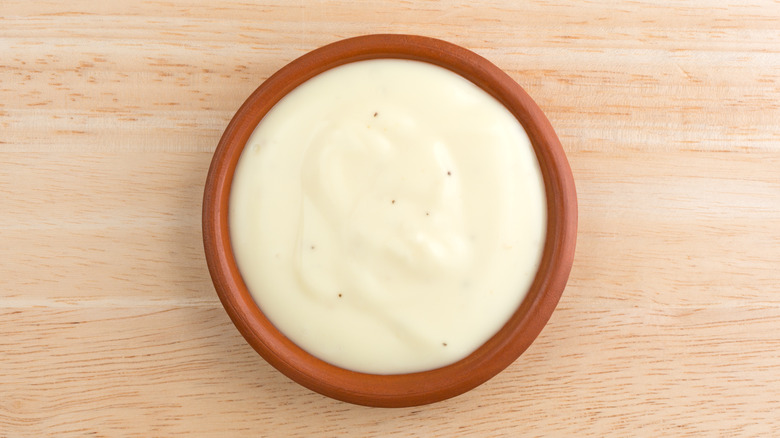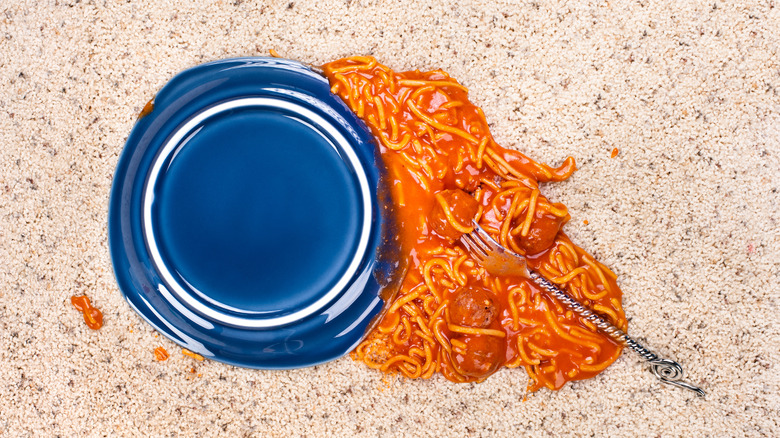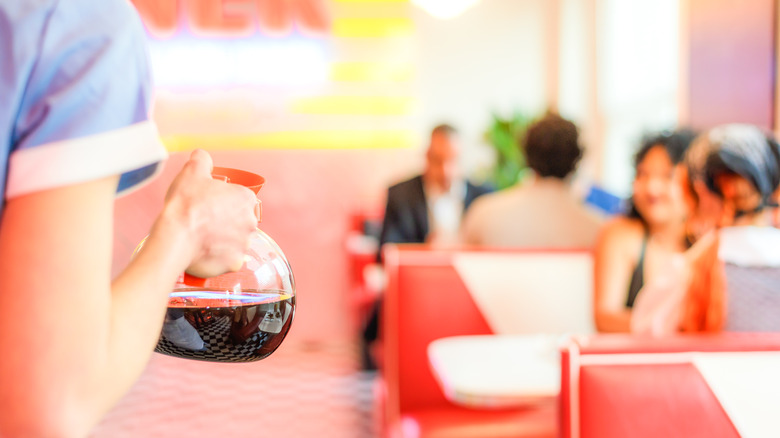11 Items You Should Think Twice About Ordering From A Diner
Diners can be great when you want a cheap, quick meal, but they aren't known for outstanding quality. While that's not necessarily a deal-breaker all by itself (sometimes classic greasy spoon comforts hit the spot), there are a few menu items you might want to avoid ordering. I'm not just talking about accidentally getting decaf instead of regular coffee, either. From cross-contamination in the kitchen to questionable food quality to improper handling, you'll want to think twice about ordering certain items from a diner after taking a peek behind the scenes. Don't get me wrong, not all diners have the same issues. Still, there are enough to make you second-guess some selections.
I worked in restaurants (including a couple of diners) for 20 years, and you won't believe some of the things I've heard and seen from fellow employees, kitchen staff, and customers. My experience in the food service industry fueled the following list of 11 items you should think twice about ordering from a diner. Keep reading to discover what my time in the field taught me so you can avoid potentially unsavory, tasteless foods and stick to the good stuff.
Fruit wedges in your drinks
Ordering a lemon or lime wedge with your water or soda at a restaurant might sound like a little treat because you'd rarely do so at home. Once I tell you how common mishandling is by the staff, I wouldn't be surprised if you avoided them like the plague from now on. I rarely saw garnish fruit being washed before they were sliced. If you're thinking, no big deal because the fruit is tucked inside, think again.
According to the Singapore Food Agency, listeria (a food-borne bacteria) is easily transferred to the flesh of fruits during preparation. Basically, when citrus fruits are cut, listeria can transfer from the peel to the flesh inside via the knife if they are not properly cleaned first. Dirty knives or prep surfaces only compound the issue.
Even if the fruit was washed before slicing, I've seen staff grab wedges with their hands, not tongs, and stick them straight in a drink. It's not ridiculous to think your servers and bartenders wash their hands frequently, but considering how often they touch money, dirty dishes, and other gross things, I wouldn't count on their hands truly being clean at every moment.
Unfortunately, these issues extend beyond diners. As a result, you might want to avoid lemons and limes at most restaurants if bacteria-filled garnishes aren't your thing. However, don't let this scare you too much. I worked in plenty of bars and restaurants that maintained healthy practices with their sliced fruit.
Soup of the day
Unfortunately, the term soup of the day can be misleading and some might even say laughable because many diners often make enormous batches that sit around for extended periods. Unless you're at the diner on the day the soup was made, which is sadly unlikely, a more accurate name would be the soup of the week or this half of the month. While it is typically good for a few days, don't expect all diner soups to be the epitome of freshness. If you spy a soup on the menu you want, you could always ask your server. There's a possibility they won't know precisely when it was made, but it's easy for them to check with the kitchen and find out. Then, you can determine whether it's up to your standards without second-guessing your order.
Aside from the misleading name, another reason you should think twice about ordering the soup of the day is that it is often a way for diner kitchens to use up nearly spoiled or expired ingredients. Instead of throwing them in the garbage in a day or two, tossing them in a soup extends their usability, thereby lowering operational costs. This may be great for some diner's bottom line but not so much for discerning customers who value freshness.
Daily specials
Just like with the soup of the day, daily specials are a hopeful way for diner kitchens to use up nearly expired or spoiled ingredients. At first glance, a daily special may seem like it contains lots of yummy, fresh ingredients, but that's only if you're lucky (and in my experience, that's pretty rare). Instead, daily specials are often a collection of ingredients close to going bad that are smothered in rich sauces or lengthy cooking processes to mask their rapidly deteriorating quality. Don't be fooled by the decadent sauces and creative presentations.
Daily specials are often priced higher than other menu items as well. I think the elevated price tag tricks people into believing they are higher-quality foods when, in fact, the opposite is true. You'll find Chef specials on the menu in more reputable restaurants, but these aren't the same thing. Daily specials are not curated by a chef to be alluring and inspired; Chef specials are. With all this in mind, if you value premium quality and freshness, it's probably best to stick to the main menu at some diners.
Salads
Diner salads may seem like a fairly good idea if you are looking to get some fresh veggies. Even so, you might want to avoid them and get your daily veggies in another meal. Salads aren't typically a top seller for many diners, so it's hard to keep fresh ingredients around to make them, particularly the lettuce. Sure, lettuce is probably used in a couple of other menu items. Still, it's not like a single leaf under a burger or a tiny garnish on the side of a burrito is enough to ensure a kitchen goes through its lettuce in a timely fashion.
I've walked into the cooler in a few restaurants and seen oversized bags of lettuce that are noticeably wilted and starting to rot. When I told the kitchen, they simply pulled the bags out and started sorting to save a couple of leaves. We all do this at home, but the standards I witnessed were nothing like the ones most of us keep in our kitchens.
Aside from freshness, diners typically don't have enough time to make salad dressings in-house. I worked at one that prided itself on making all of the salad dressings, but that's the exception to the rule as far as I can tell. Typically, diner dressing is poured out of a massive plastic jug, and it isn't even as good as the stuff you'd find at the grocery store.
Seafood
Seafood served at diners is almost always frozen, possibly for long periods. While this helps a diner expand its menu without trying to keep fresh seafood on hand, which is difficult no matter what, it certainly doesn't meet the quality standards of coastal seafood lovers. From a bland taste to poor texture, frozen seafood doesn't measure up to the fresh stuff. Many people enjoy frozen breaded seafood from time to time, like with fish and chips or fish sticks, but don't expect all diners to live up to your expectations in this realm.
Frozen seafood can be quite temperamental regarding defrosting, handling, and cooking. When not done right, it may even lead to contamination, resulting in food poisoning. As a result, it's best to avoid seafood options at any diner that doesn't make you feel 100% confident.
Depending on how diner seafood is defrosted, frozen fish can become mushy as well. When left on a countertop for rapid defrosting, a mushy texture is difficult to avoid. Considering many diner kitchens need ingredients quickly, there's a fairly good chance there won't be time to defrost seafood properly every single time. I've witnessed the rapid defrosting of many items during my time working in restaurants. While it can be done safely in some instances, seafood tends to deteriorate when not handled with the utmost care, so proceed with caution.
Well done steak
I'm sure you already know that diner steaks aren't going to be the epitome of quality. Just because they're cheap doesn't necessarily make them good, as is the case with many things in life. Even if you are expecting most diners to serve a lower-quality cut of beef, ordering it cooked well done will likely let you down. Low-cost steaks are tougher than premium options from the start, but when you cook them for extended periods, they rapidly lose their moisture and become, as I've heard chefs say, "hard as bricks."
There are several easy ways to improve a cheap cut of steak, like basting it in butter and sprinkling it with generous amounts of salt and other seasonings, and many diner cooks do everything they can. However, if you order a low-quality steak cooked well done, there's really no saving it. Regardless of the enhanced flavor and cooking techniques, what you get on your plate is a tough, dry steak that is barely chewable and potentially hard to stomach.
I tried to warn people at many of my restaurants about the pitfalls of ordering their steaks well done. Still, everyone is different, and many people genuinely prefer their steaks that way (even though they know it will be tougher). My half-hearted warnings didn't do much to sway people's opinions on this matter, but the frequency at which people would send them back gave me all the reassurance I needed.
Foods cooked on the flat top if you're vegetarian or vegan
If you follow a plant-based diet, you probably think ordering a vegetarian or vegan menu item ensures it will align with your dietary preferences. I did, but I was wrong about food grilled on the flat top. Unless you specifically tell your server and ask for special allergy preparation, chances are high that your food will be cross-contaminated with meat and dairy items at some diners, particularly on the flat top.
One of the great things about cooking on a restaurant flat top is that they are huge, allowing cooks to make a collection of dishes simultaneously. Unfortunately, this also elevates the chances that they will cross paths. If you order a veggie burger, it will likely be cooked right next to meat burgers. Other flat-top foods, like hash browns, run the same risk because they are cooked alongside eggs, bacon, sausage, and more. This might not be a big deal to some people, but vegetarians definitely don't want beef grease in their food because it can easily lead to stomach aches and more.
There are plenty of ways for a reputable kitchen to prevent cross-contamination, but food safety for vegetarians is not at the top of the list for all diners. They push out food at rapid speeds, which is great, but if cooks aren't specifically told a dish is for someone following a plant-based diet, the extra attention needed could fall through the cracks.
Fried foods if you're gluten-free
To be safe for celiac or gluten-free diets, deep-fried foods must be cooked in a separate deep fryer, not used for glutinous foods. According to Pitco, even if the oil is brand new, tiny gluten particles can lodge themselves in cracks on the deep fryer and leech into gluten-free foods. With this in mind, deep-fried foods should be avoided by diner guests with a serious gluten intolerance.
Upscale restaurants often have a separate deep fryer to accommodate special diets, but this is rarely the case in low-end diners, either because of a lack of space or lower kitchen operating costs. Instead, they have one or two deep fryers, and everything from chicken to french fries to mozzarella sticks gets tossed into the same oil. So, if gluten-intolerant people want to play it safe it's probably best to steer clear of ordering anything from the deep fryer. Otherwise, the chances for an adverse reaction are higher than you might expect because only the tiniest amount of gluten is needed for symptoms to develop.
Hollandaise sauce
Later in the day, many people agree it is best to avoid hollandaise sauce like the plague. This may be somewhat dramatic, but you'll never catch me ordering it after a kitchen has been open for more than a few hours. The reason lies in its early preparation, storage at room temperature, and the presence of egg yolks. When all three of these factors converge, the risk for hollandaise sauce harboring bacteria is much higher than I am willing to risk. In fact, uncooked egg products, like Caesar dressing or hollandaise sauce, shouldn't be left in room temperature conditions for more than two hours (via Centre for Disease Control).
Making hollandaise sauce is pretty easy, especially if you use a blender instead of a whisk. Still, many diner kitchens are incredibly busy, and fresh hollandaise simply isn't possible for every plate. So it is prepped in advance to quickly be slathered on dishes as ordered. While the sauce waits for application, it is often kept on the line close to where the finished food is presented, at least in my experience. If you don't know, the line is hot, and let's face it, hot raw egg yolks are gross. Of course, there's also the potential for bacterial growth, like listeria and salmonella, when egg products are not refrigerated. Even if eggs Benedict is calling your name, I'd skip them at most diners if you aren't within a few hours of opening.
Blue cheese dressing
Blue cheese dressing is delicious when made correctly, but don't expect to get the good stuff from every diner. This might sound a bit extreme, but I worked at a diner where they mixed a few blue cheese crumbles into ranch dressing and called it a day. If you love both kinds of dressing, this might sound like a benefit, but it's not like they threw enough blue cheese crumbles in to make a real difference. If you put the ranch and blue cheese dressings side by side, it was nearly impossible to tell which was which. I'd have to stir for a while before I could see any crumbled surface, and that was the only indicator.
Aside from the obvious lack of care that went into making blue cheese dressing at the place where I worked, people often sent their "blue cheese dressing" back because they thought they mistakenly were given ranch. Unfortunately, they didn't know that a new ramekin wouldn't provide the blue cheese they were after. I'd typically replace their dressing once and try to extract as many blue cheese crumbles as I could, but even that wasn't sufficient for many people, and I can't blame them. At that point, I would simply tell them what was up.
Pasta with marinara
Pasta with marinara isn't the end of the world at a diner. However, bland and generic are pretty much guaranteed at most greasy spoons. From the boxed pasta to a pre-made sauce, don't expect every diner's pasta and marinara dish to provide you with anything special. I know, sometimes there's nothing wrong with store-bought marinara, but the stuff they use at a diner won't be a good option like Rao's or Classico. For example, in the place where my sister worked, the marinara was a bright red-orange color, similar to SpaghettiOs, and it lacked complex flavors of any kind.
Part of my family is Italian, so I might be somewhat pickier about my pasta and, as we call it, "red gravy." Still, I know what excellent, passable, and awful options are, and many diners tend to fall into the latter category. The sauce is often watery and bland, and the pasta is likely overcooked, at least by my standards.
Aside from a lack of flavor, you may want to avoid pasta and marinara dishes at some diners because they don't give you a lot of bang for your buck. Compared to heating up the ingredients at home, the cost is astronomical.
Methodology
I worked in the food service industry for 20 years in diners and other types of restaurants and bars. During that time, I heard from colleagues and witnessed many horror stories regarding how products are made and served. My sister also worked in a 24-hour diner for a while, and it wasn't pretty. In fact, it made me question my food choices for quite some time.
While these experiences and stories largely populated my list of diner foods to avoid, I also considered food safety resources, news stories, and more to help shed light on potential diner food issues because, after all, my time in the industry doesn't speak for everyone.
As I briefly mentioned at the beginning of this article, my warnings don't apply to all restaurants or diners. There are plenty of top-quality places where you can expect to consistently receive excellent food, no matter the time of day or product. However, just because a place is in business doesn't mean they will do things the right way. So, when visiting an inexpensive, lower-quality diner, proceed with caution when it comes to the menu items discussed above.

